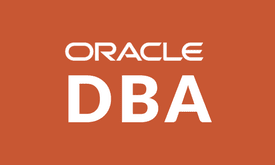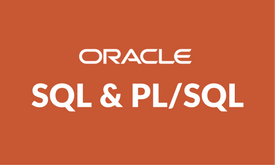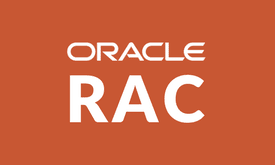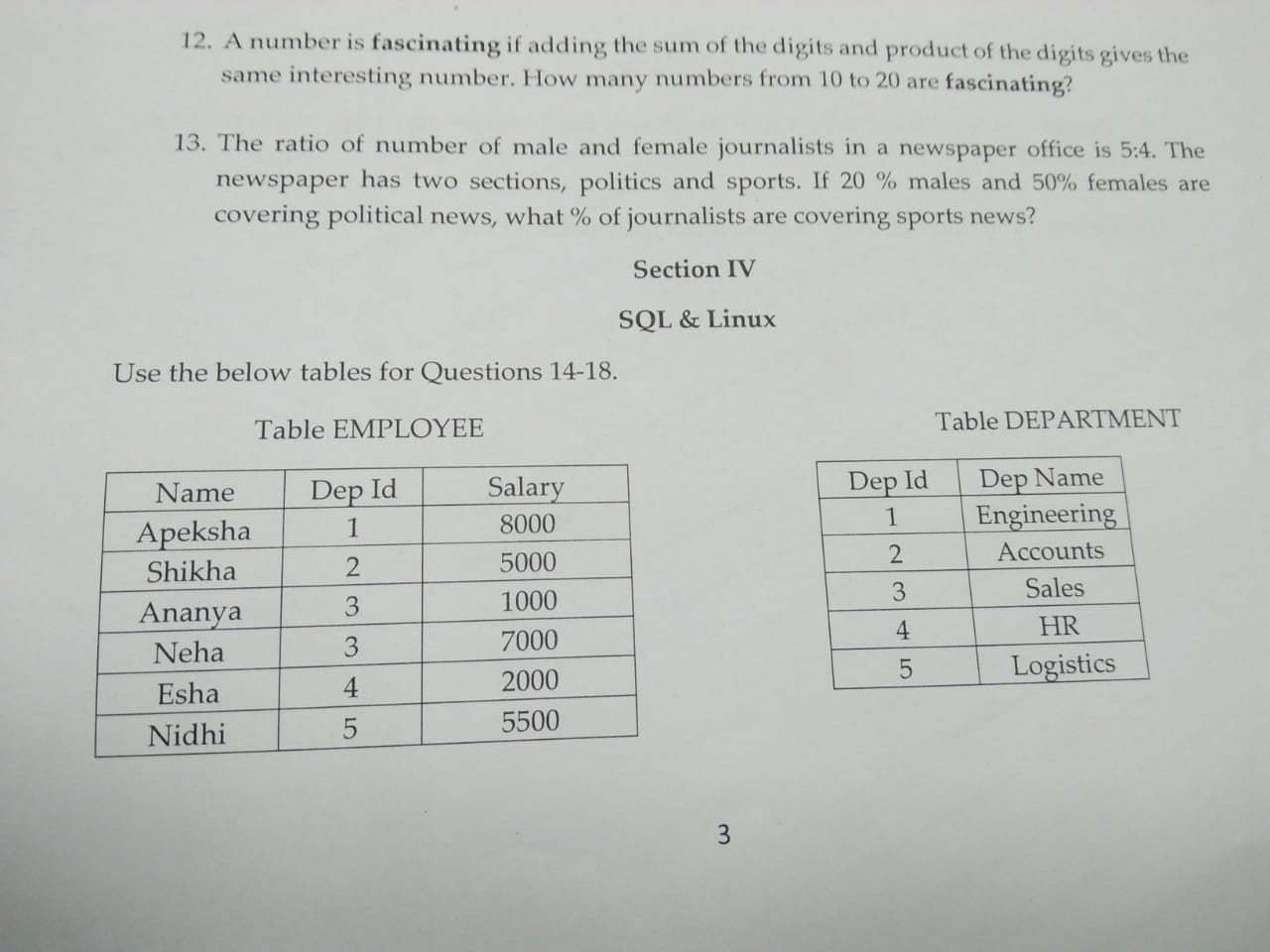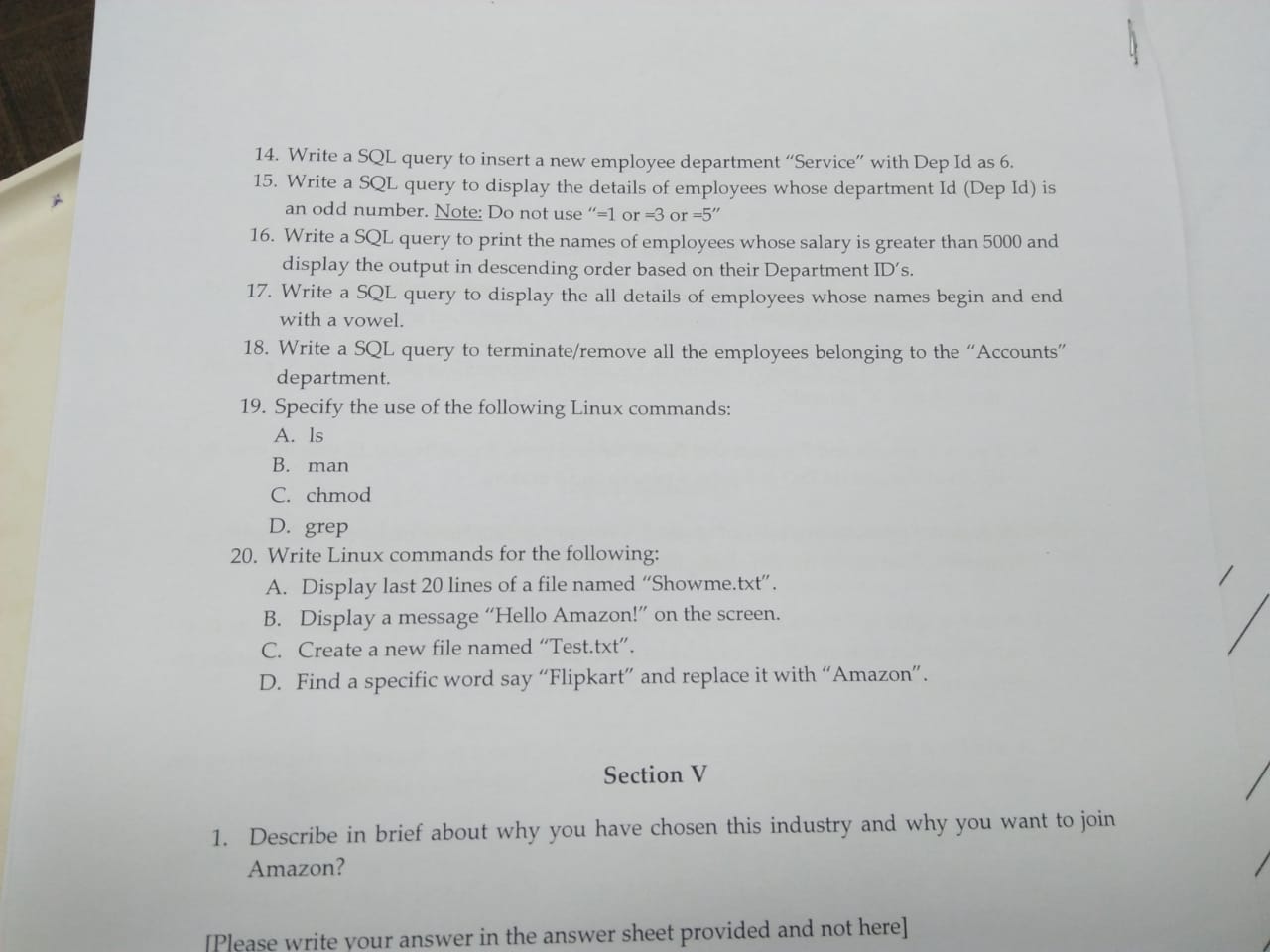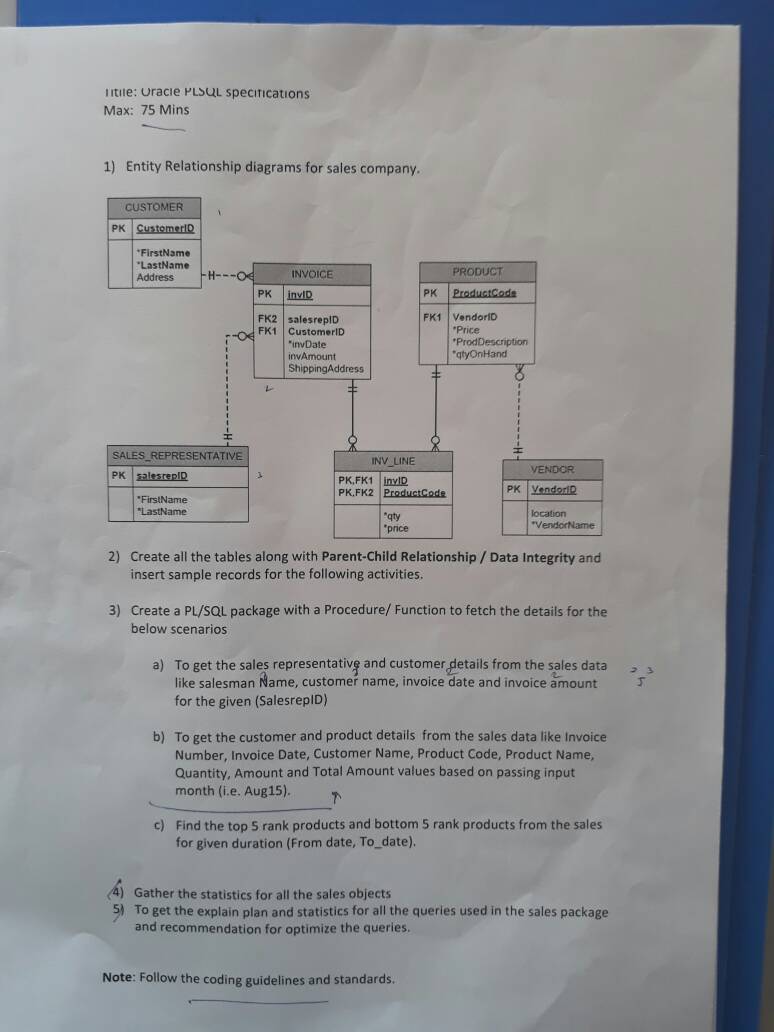Evolving as the best known oracle dba training in chennai, india and usa greens Technologys Porur is proud teaching body with full fledged assistance to the current industry needs. We have a well planned and directed oracle dba 12c course curriculum that goes well with the industry needs and bearings. Here you will get a chance to get in touch with some of the expert and highly proficient software industry experts, who have an already practically dealt experience with the Oracle workability standards and are here to train you in the relative field with over 9+ years of experience in the real time environment.
Oracle DBA 12c Training
Our Oracle DBA Training is totally aimed at teaching and training students from the beginners stage to the already existing employees, as well. We have a RDBMS trademarked Oracle course structure that is well demanded in the industry. Our expert panel and the well defined course structure have made us evolve as the best oracle dba 12c greens Technologys Porur in chennai, india, usa, canada and australia covering the required syllabus and course needs.
Course Objectives
With your successful course completion of the course of Oracle Training, you can be operational in terms of-
- Introduction to the Database Architecture
- Installation of the Oracle Database Software using the core DBA tasks and related tools
- Creating and managing the Oracle Database
- Learning the process of backup, recovery, security, schema objects management, flashback operations, data corruption, etc.
- Running and managing recovery manager, incomplete recovery, non-critical losses
- Learning Advanced Oracle and DBA 12c Training
- Getting an insight of the OracleApps related DBA Training
- Obtain a complete Performance Tuned Training
- Receive SQL Server based DBA Training, as well
About Oracle Trainer
- Dinesh work as an Oracle Consultant & Instructor, He has over 15+ years of Oracle Implementation experience and recognized expert in Oracle SQL and PLSQL technologies, advanced analytics and Oracle data mining.
Mr. Dinesh specializes in Oracle Discoverer, Oracle OLAP and Oracle Data Warehouse Builder.
- He is also been as Senior Instructor of Oracle University and provided 200+ Corporate trainings, trained 25000+ freshers and corporate & fresher professionals.
He is an Oracle Certified Master (OCM). Expertised with RAC, Data Guard, ASM, Oracle Exadata, RMAN, Oracle Performance Tuning, Streams, Security & more.
He is among few of the Oracle Certified Master (OCM's) in the World to achieve below certifications in his area of research.
- Oracle Certified Professional (OCP) 9i
- Oracle Certified Professional (OCP) 10g
- Oracle Certified Professional (OCP) 11g
- Oracle 10g Certified RAC Expert
- Oracle 10g Certified Master (OCM)
- Oracle 11g Exadata Certified Implementation Specialist
Conducting regularly online- training for US peoples in all time zones (PST,CST,EST,HST,MST) My training is 100% Money Back Guarantee (Tuition fee) for Passing Online Examination with cent percent and ready to go live with production system immediately. If my training does not satisfy you at any point of time, even during the training period, you need not pay the tuition fee.
100% practical training only. It is not a slide show training program / theory class program. At the end of this class, definitely you will refer your colleagues / friends / relatives for my training.
Course Curriculum
Curriculum
Introduction to DBA
- What is Database? Why Database?
- Major Databases and Database Vendors
- Roles and Responsibilities of DBA
Oracle Database Architecture
- Database & Instance
- Memory Structures – SGA, PGA
- Background Processes
- Server Processes
- Database Files
- Physical & Logical Structures
Installing Oracle 12c Database Server
- Requirements for Installation
- Oracle Universal Installer (OUI)
- Installing Oracle Software
- Silent method
Creating Oracle Database
- Planning the Database
- Creating Database
- Silent
- Command line
Starting & Stopping Database
- Startup & Shutdown modes
- Starting & Stopping the database
- Read-only & Restricted modes
Parameters & Parameter Files
- Initialization Parameters
- Static and Dynamic parameters
- Parameter Files
- Text & Server Parameter Files
- System & Session Level Parameters
- Changing Parameter values
Data Dictionary
- Understanding Data Dictionary
- Static & Dynamic Performance Views
- Using Data Dictionary
Managing Diagnostic data
- Diagnostic files
- Automatic Diagnostic Repository (ADR)
- Viewing Diagnostic data
Managing Data Files & Tablespaces
- Tablespace and Data Files Concepts
- Blocks, Extents, Segments
- Understanding Space Management
- Creating & Managing Tablespaces
- Big file Tablespaces
- Tablespace Quotas
- Configuring Multi-Block Support
Managing Undo Data
- Transactions and Undo Data
- Managing Undo data
- Creating Undo Tablespaces
- Configuring Undo Retention
Managing Temporary Tablespaces
- Understanding Temporary Tablespaces
- Managing Temporary Tablespaces
- Temporary Tablespace Groups
Managing Control Files
- Understanding Control Files
- Multiplexing Control Files
- Backing up Control Files
Redo Log Files & Archiving
- Online & Archived Redo Log Files
- Managing Online Redo Log Files
- Fast Recovery Area (FRA)
- Configuring Database Archive mode
Oracle Managed Files (OMF)
- OMF Concepts and Use
- File Naming Conventions using OMF
- Creating Tablespaces with OMF
User Administration
- Creating Users Accounts
- Account management
- Schema , Session, Killing Sessions
- Using profiles to implement complex passwords and resource limits
Privileges & Roles
- Understanding Privileges
- Managing Privileges
- Understanding Roles
- Managing Roles
Oracle Net Services
- Understanding Oracle Net Services
- Net Listener, Naming Methods
- Net configuration tools- NETCA, NETMGR
- Configuring Listener & Naming methods
- Establishing Database connectivity from Oracle Database Clients
- Configuring Shared Servers and Dispatchers
Database Links
- Distributed Databases
- Creating Database Links
- Managing Database Links
Backup and Recovery using RMAN
- Backup & Recovery Concepts
- Recovery Catalog
- Full & Incremental Backups
- Image Copy & Backup Set backups
- Backup & Recovery using RMAN
- Hot & Cold backups using RMAN
- Complete & In-Complete Recovery
- SQL & DESCRIBE commands in RMAN
Flashback Technologies
- Oracle Flashback Technologies
- Flashback Database
- Flashback Table
- Flashback Drop Table
Oracle Data Pump
- Concepts of Logical backups & Refresh
- Data Pump Exports & Imports
Transportable Tablespaces
- Concepts of Transportable Tablespaces
- Transporting Tablespaces across Databases
Database Cloning
- Cloning Concepts and Considerations
- Cloning Techniques
- Cloning Oracle Home and Database
- Manual Cloning
- Cloning using RMAN
Data Guard
- Overview of Data Guard
- Benefits of Implementing Data Guard
- Standby Database Concepts
- Implementing Physical Standby database
Database Patching
- Patching Concepts
- Interim Patches, CPU, PSU patches
- Patch Sets
- Downloading & Analysing Patches
- Applying Patches
Database Upgrade
- Understanding the upgrade process
- Upgrade methods
- Upgrading Oracle11g to Oracle 12c
Database Performance Tuning
- Oracle Tools for Performance Tuning
- Instance & Database Tuning
- AWR, ADDM, ASH
Oracle Multitenant Architecture
- Multitenant Architecture
- Pluggable Databases (PDB) & Container Database (CDB)
- Creating & Managing CDBs & PDBs
- Users, Roles, Privileges in CDB
- Parameters in CDB
- Backup, Recovery of CDBs & PDBs
Who Can Learn?
Any Fresh Graduate or an existing employee can take up this course with any of the technical background in software. Anyone looking for a transformed career prospects in Oracle database management field can also take up this course for becoming an expert Oracle Database Manger or Analyst.
- Aspirants looking for permanent jobs in big IT corporations
- Students/scholars willing to start their professional career as a “Oracle Database Engineer/Manager/Analyst” with any of the IT giants
- Proficient IT professionals who are willing to switch their field of work towards database management field
- Aspirants with additional IT skills and educational background who are willing to gain practical freelancing experience in the related field
- Aspirants willing to work as “Freelance Database Engineer/Manager/Analysts”
Course Reviews
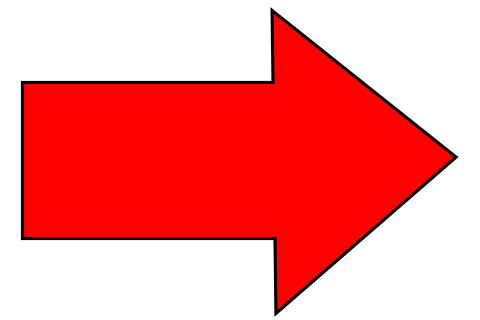
|
1, Create one procedure
2,create one function like when I input a value it has to square like 3*3 , 2*2 power of model.
3, Write anonymous block using two cursor .
4, write anonymous block define two column in declaration and fetch the all the details using FOR loop?
5, update with decode statements
6, Delete duplicates using self join I don’t want usual one like subquery.
7,Difference between procedure and functions.
8, how could you execute the functions . Gave one scenario
9, What are the methods of execution in function,
10, advantages of packages.
11,Using sqlloader How to skip first when insert a values.
12, Your team structure
13, how about SLA scenario ,
14, write a query full outer join ,
15, scenario given how many will returns using full outer joins.
16,how about SDLC phases works
17, Tel about your personal things .
18,How SQL execution works
19,Will you able to support on week ends.
20,How will you hundle your project do you have any strategies which you will follow
1. Can we use truncate inside trigger? DDl operations inside trigger.
2. Select employees whose salary is not null and not equal to 100
using nvl function.(supposed to use only nvl function for both conditions)
3. Simple Equi Join and max(salary) queries.
4. How to display sysdate in oracle date format?
5. Difference between delete and truncate(interviewer wants different points for this, not usual dml and ddl, where clause- when I started with delete is dml interviewer stops me and said no usual point)
I answered using High water mark point of view.
6. Instr and substr questions
7. select employees name which is starting with 'S' and has 6 characters.
8.Basic Unix Commands.
Then normal usual query syntax!







1.Write a plsql blocks using bulk collect, to select rows from employees table and insert it into another table
2. Select first 3 employees details for each department
3. Select the number of 'a' in a string
4. What is subquery and correlated sub query
5.Difference between views and materialized views
6.Diff between procedures n functions
7.Where did u use refcursor in the project
8.How to delete duplicates using joins
9.Diff types of subqueries
10. Collections and types
11. Which collection u used in the project
12.Analytical function , triggers , index , performance tuning. ,
13 You have 10000 records in one table and u have to copy 5000 records to another table...
14. Group function
15. Exceptions,package,function,procedure difference,analytical functions ,using exception some problems
1.What is normalization?
2.How to convert Listtag into normal table view?
3.I have 100 lines of procedure and 23 line not executed but I want remaining line will be executed what You do?
4.Where did you use partition table in your application?
5.What is collection which collection you used recently in your application?
6.What is SQL loader?
7.delete duplicate using join?
8.sub query type and recently used sub query and how did you use?
9.what is correlated sub query did you use so for?
PL SQL SET 3 QUESTIONS
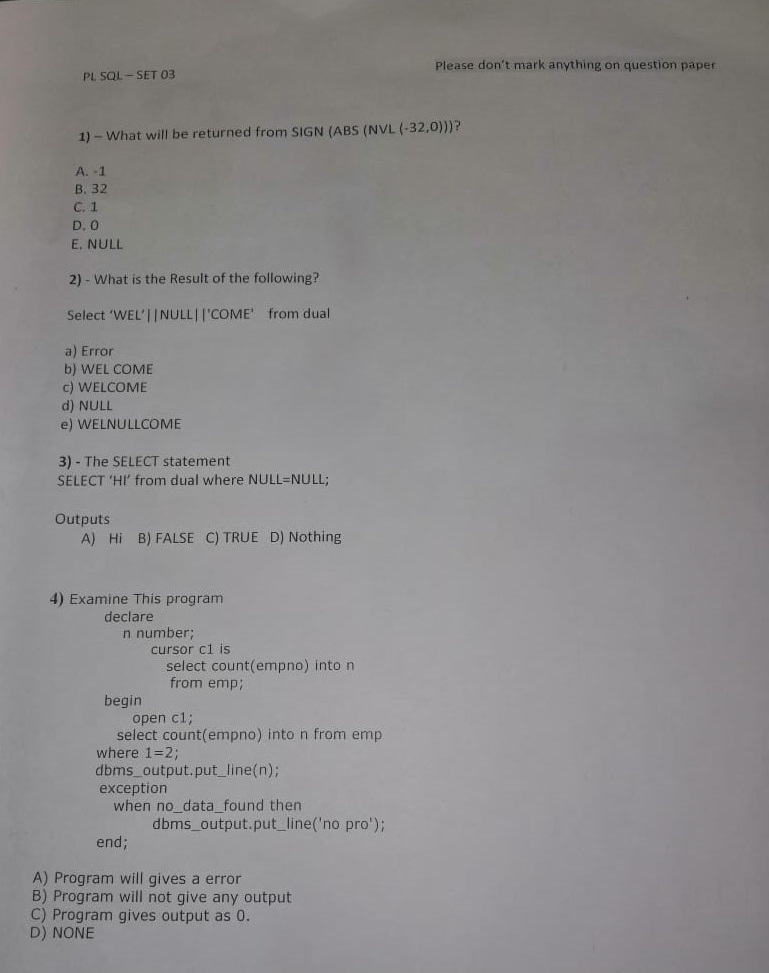
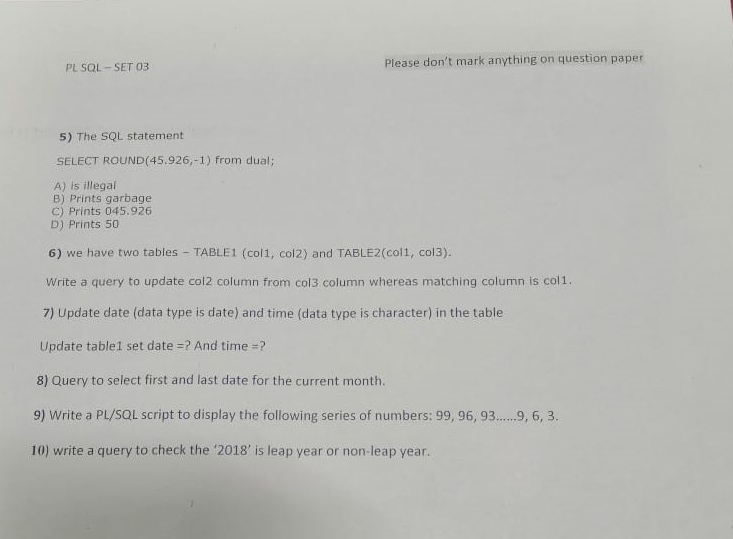
1,brief about your self and your current project.
2,have you worked on development environment.
3,Tell me the last procedure code.
4,What is collection and Types.
5,scenario given based on Varray. I have an variable which contains 100 records now I want delete last 10records.
6:Save exceptions and pragma
7,Why we use for all and save exceptions
8,Analytical function query scenario given,
9,what is DBMS profiler and explain plan.
10,why you used DBMS profiler
11, exceptions
12, scenario given based on exceptions. My procedure have to run without getting error msg which types of exception you will use.
13,Listagg
14, Tel me something about View.
15,merge query
16,Do you know about dbms scheduling job.
1.SQL loader.
2.What is constraint?
3. Difference between primary key and foreign key?
4.What is view?
5. Difference between delete and truncate?
6.can we perform dml operation in view?
7.difference between procedures and functions?
8.rank & dense rank.
9.cursor in detail.
10.null functions
1.How ur getting requests
2.If u need any clarification in task who is the contact person
4. What r the things u ll do once task completed
5.Aggregate functions
6.Listagg with Concate query
7.Mview
8.Can u able to create Index for columns which is having null values? Will Optimizer read that index?
9.Hints
10.Merge
11.All loading concepts(sql loader detailed)
12.Procedure using truncate
13.Procedure detailed
14.Functions detailed
15.Explain plan
16.About performance tuning
17.Bulk collect & bulk bind
18. Save exception
19. Few Unix commands
20. Use of anonymous block
21.Cursor
22.Collection
1. Tell me about yourself?
2. Performance tuning?
3. Index is invalid what you will do that?
4. How you rebuild the index?
5. Explain plan?
6. Gather stats?
7. What happens if gather stats command executing?
8. Table partitioning and its types?
9. Mview and its refresh method?
10. Collections ?
11. How to use nested table inside the plsql block?
12. Explain Varray?
13. Have you experience in 11g and 12c?
14. What is cursor ?
15. Refcursor ?
16. Dynamic sql??
17. Is it possible to use execute immediate for select statement?
18. Pipeline function?
19. Forall with save exceptions?
20. Where will you get the failed records?
21. Difference between rank and dense_rank?
22. Difference between lead and lag?
23. Row_number?
24. Difference between delete and truncate?
25. Physical classification of oracle?
1. Tell about your self
2.what is index . types and when you used index
3. What is trigger and types
4.exception and types
5.how to alter the sequence value 10000 to 5000 (reduce)
6.what is pragma autonomous transaction ..and where it is used
7. How to find the error in SQL and plsql
8. Table A having 10 records , table B having 6 records .. I am insert 4 records in Table A then truncating table B ...now insert 3 records in Table A ...then insert 5 records in table B now I am going to do ROLLBACK table A and Table B records ?
9. What is function and its types
10. Employees table having column Emp_I'd ,Dept_I'd,Dept_name,
salary....
Department table having column is Dept_I'd,name
Write a query for above two tables
(1). Create syntax for this two tables
(2). Find the duplicate records in employees table based on department table
(3). Select highest salary for each department ..
11. Materialized view and why you are using in you project
Tell about yourself
Tell about your project
Delete duplicate records from table
Joins and types
Write a query on 5th maximum salary
Diff b/w delete,drop,truncate
Diff b/w views and materialized view
What is gtt
What is Stored procedure and example
What is compound trigger
Functions and purposes
When you used pragma autonomous transaction
What is dynamic SQL?
Some queries asked
Today I attened 2 round in chain sys..
1.about ur self2. Performance tuning
3. What is index
4. Last incident request
5.last change request
6.Which employees getting max salary than manager salary
7.write a query We having emp table in that who is getting max salary than Krishna.
1st round questions
1. Tell about yourself
2. What is analytical functions?
3. What is cursor and its types?
4. What is exception handling and its types?
5. What is collections and its types?
6. What are the types of triggers?
7. What is compound trigger?
8. What is mutating table error? How you over come that in your project?
9. Difference between cursor and ref cursor
10. What is package?
11. What is overloading?
12. Write a procedure for scenario based question
13. How many procedures you have created so far?
14. Explain about performance tuning
15. Steps to improve the performance of the query
Chain-sys interview questions
1.introduce yourself
2.what is truncate, delete
3.how to delete duplicates
4.what about triggers and types
5.diff b/w decode and case
6.cursor types
7.exception handling
8.have u handled exception in ur project
9.why we use bulk collect
And then two scenario based questions
Chain-sys interview questions
About your self
Do you know Oracle forms
Different between detele and truncate
Different between case and decode
What is cursor and attributes and types
Why we use ref cursor
What is aggregate functions
What is listag function and quirey
How to delete duplicates in table
Different between rank and densrank
What is utl_file
What is table partitions
Thanks
Chain-sys interview questions
1.Tell about yourself
2.describe about single row function
3.describe about group function
4.describe about joins
5.if there is table t1
First we will insert then update , then alter table after that we will give rollback.what is the output.
6.write query to show first 5 highest salary.
7.difference between %type and %rowtype.
8.difference between unique key and foreign key.
9.how will you call procedure and function.
10.write store procedure where employee_id input and salary as output.
11.how will you raise an error.
12.how will you use sqlloader, describe the steps.
Chain-sys interview questions
1.introduce yourself
2.what is truncate, delete
3.how to delete duplicates
4.what about triggers and types
5.diff b/w decode and case
6.cursor types
7.exception handling
8.have u handled exception in ur project
9.why we use bulk collect
And then two scenario based questions
Chain-sys interview questions
1st round
1. Introduce yourself.
2. Rate in SQL and PLSQL.
3. Explain about subquery.
4. Explain right outer join.
5. Explain performance tuning.
6. What are the methods using in performance tuning.
7. Explain views.
8. Datas insert in view, it will affect in master table?
9. Different user inset the data in same table, what will happen.
10. Explain about trigger.
11. You can use commit inside trigger?
12. Explain about pragma autonomous transactions.
13. Explain about anonymous block
14. Different between procedure and function.
15. Able to call procedure inside function?
16. Explain about cursor.
17. Cursor types.
18. Explain refursor.
19. Explain about bulk collect.
20. Explain about exception.
21. Exceptions types.
22. Advantages of bulk collect.
Chainsys interview questions
Tell about Ur self and daily work
Dml and ddl
Delete and truncate different
SQL loder
Log file
Views
Performance tuning in SQL
What is the use of procedure in Ur project
Where Ur using function in Ur project
Questions from resume
U know about Oracle forms
Structure of plsql block
Exception handling
List out the Predefine exception handling
1.Tell about your self
2.can you use any function in your project
3. SQL function
4.Error handling
5. Second maximum salary - write query
6.Analytical function
7.DDL
8.TCL
9.DML
10.PROCEDURE
11.Trigger
12.pragma autonomous
13.have u used pragama autonomous in your project...
14.difference between decode and case
15. Difference between NVL and NVL2
Chain sys 1st round interview question
1.what is views uses of views and write syntax
2.what is synonym uses of synonym. Where ur is used in our project
3.what is index
4.what is constraint uses of constraint where ur in used in our project
5.what is cursor and its types
6.what is packages how to execute the package
7.structure of plsql block
8.where is located in ur company
1. Tell me about yourself.
2. Stud-table
slno same gender smark
1. X M. 81
2. Y. M. 75
3. Z. F. 79
Grade-table
From_mark. To_mark. Rank
1. 45. 5
46. 60. 4
61. 75. 3
76. 90. 2
91. 100. 1
Output:
Sname. Gender. Rank
X. M. 2
Y. M 3
Z. F. 2
Asked not to hard code.
2. Write a trigger using the above stud table in which we can modify the sname and gender column but it should not allow to modify smark column.
3. How to add a new parameter to an already existing procedure.
4. Diff b/w view and materialized view.
5. What is pragma autonomous transaction and where you used in your project.
6. Asked to write scenario based programs using implicit cursor, explicit cursor, bulk collect, ref cursor and collections.
Beyontec Interview Questions
1.What is index
2.wht is cluster
3.shall we create index by using select statement
3.types of join
4.showed 2 tables t1 and t2 asked output for inner join, outerjoin (left,right)
5.What is collection
6.write a procedure using collection for inserting data's from table t1 to to
7.Write a trigger to show exception when someone try deleting rows from table t1
8.how to disable multiple triggers in a table using a single query
9.what are the features of 11g and 12c
1.tell me ur roles and responsibilities
2. External table and table partitioning
3.in table partitioning using joing date of the employee do the interval partitioning
4.performance tuning
5. What are all the stored procedure u created
6. How to data migrate from one server to another server
1. Tell about your self
2. Roles and responsibilities
3. How to insert and update in single query
4. Types of index
5. Explain bree and bitmap index
6. Diff view and mview
7. Type of constraints
8. Explain forgin key
9. Perform tuning
10. Explain about sequence
11. What is the cursor
12. Where u r using in your project
13. You have any thing with out using cursor to move the data one table to another table
14. Explain Triggers
15. Explain row level trigger and where u r using in your project
16. Explain about partition
17. Explain the range partition
18. Do you know unix
19. Do you know shell scripting
20. We are looking for DBA developers
Tell about your project
Working timing
What's index and type
What is view
What is synonym and purpose
What's constraints
Write query need answers like this Mahesh, suresh
Different between stored procedure and procedures
R u working now..
Y did u leave the job...
What is c in 12c what is g in 10and11g
1.procedure vs function
2.wat is trigger
3. Can we create index on view?
4.what is index?
3. Write a full query for a table t1 a 0,1,0,1 update 0 as 1 and update 1 as 0
4. Delete duplicate values in a table
5.write 2 max sal in a table
1. Explain ur project
2. Write a query to get n th salary
3. Rank the employee using rownumber
4. Analytical fn
5. Synonym
6. View
7. Materialized view
Why we use mview
8. Index
D/b bit map and b tree index
9. Forward declaration
10. Pragma autonms trasctio
11. Constraints
D/b primary key and foreign kry
12 Stored procedure and local procedure
13. Update the gender f as m, m as f
14. Emp_name
Raja
Mani
Get output as raja,mani
1st round
1.Views
2.Index
3. difference between views and mviews
4.triggers
5.procedure
6.function
7.difference bw procedure and function
8. Difference bw joins and set operator
9 .joins types
10 cursor
11.exception
12.difference bw runtime error and syntax error
13.any ideas about MySQL
14.write program user defined exception
15. Difference between union and Union all
16.difference bw statement level trigger and row level trigger.
17.constraints
18 . difference between primary key and unique
1 What is materialized view. What types of refresh it have ?
2 What is index ? Types of index ?
3 What is collection ? Types of collection ?
4 Difference between index by table and nested table ?
5 If you declare index by table or nested table what will
Be the default value ?
6 What is cursor ? Why we are using cursor? Why can't we use index by table or nested table ? The difference?
7 Difference between function and piperow ?
8 How does the explain plan work ?
9 Do you know gather statistics ? Explain ?
10 How will you find tablelock ?
11 What is mutating error ?
12 What is exeception ? Types ?
13. Tell some predefined exception you gone through?
14 Why we use others in exception ?
15 what is hints ?
16 What is table partitioning ?
17 In bulk collect what is the use of save exception ?
18 You are using save exception how will you find the
Records that are not inserted ?
19 In table which scan will perform faster. Unique or Full scan ?
20 Difference between analytical function and aggregate functions ?
21 How you write rank functions ?
1.technical stuff which u have
2.how many incident u r working on daily basis
3.tell some frequently receiving incident and how u resolve it
4.How u r using SQL query in Ur current project
5.Last faced issue
6.future career plans for next two years
7.are u willing to learn new technologies
8.which one u r preferring support or Dev
1.what are the types of table partitions
2.do you known about composite partition.
3.view and materialized view different
4.delete and truncate different
5.aggregate function and analytical function different
6.rank and dense rank difference
7.what are the hints use used
8.how to insert bulk data
9.what is save exception
10.have u work with perform tunning
11.how will u to the query optimization
12.where will index scan increase the performance and where full scan increase the performance
13.have used utl function. Why u use utl function
14.about cursor
1. About ur self
2.project
3.day to day activities
4.do you have experience in bulk collect, collection
5.do you have experience in creating table view constraints
6.in which place is your company.
7.company process
8.noties periods
2nd round:
1.Tell me about your self?
2.What is diff between stored procedure?
3. What is cursor?
4.what is view?
5. What is dbms jobs
6. What are indexs and types?
7. What is a package
8.
Salary table
Sal column:
15000
20000
14000
Write a query to get 1st name ,max of salary from salary table.
9. T1 table
A
B
A
B
Update B in place of A and A in place B. What is the query sir?
1. Self intro
2. Day to day activities
3. Package and forward declaration
4.Difference between collection and record
5.identify the duplicate rows
6.Complexed need o/p like this
C
O
M
P
L
E
X
E
D
7. Gtt
8. In gtt concept one table created on commit preserve rows. User doing some activities in session 1 and suddenly he power off the system ,now the data will save in gtt table or not
8. Trigger
9.which methodology you are working
10. In toad what is the data module.
MSC TECHNOLOGY QUESTIONS
1.Tell about u r self
2. Synonyms and Sequence
3. What is primary key and how it works?
4. What is cursor and types?
5.tell how you work on release management.
6.write any procedure for % rowtype
7.views and mviews
8. Write correlated subquery
9. Exception and how its works?
10. What is know exception.
11. What is index? use of index in your project?
12 in Mview how we insert data and types of Mview?
MSc today interview question 1st round:
1.tell about yourself
2.explain your project
3.diff b/w views and tables
4.what is triggers and triggers type
5.diff b/w row level trigger and statement level trigger
6.diff b/w union and union all
7.what is index and it's type
8.diff b/w b*tree index and bitmap index
9.what is ref.cursor
10.what is join and it's type
11.diff b/w equi join and outer join
12.what is constraint and it's type
13.diff b/w primary constraint and unique constraint
14.what is Mviews
15.what is packages and uses of packages
16.what is Sequence and write the syntax
17.performance tuning
18.write the feature in 11G and 12c
19.A
1
2
3
6
7
How many time trigger fires in row level
And how many time trigger fires in Statement level above the table
MSC interview questions
1.what is table
2.what r the constraints
3.what is index and its types
4.what is joins and types of joins
5.why we use join
6.give join example based on ur project
7.what is table partitions why we are using
8.what is view
9.type of views
10.why we r using view
11.what is force view
12.what is materialized view and its type
13.why we use materialized view
14.what is materialized view u created explain based on ur project
15.how will log file created
16.what is methodology ur using
17.in performance tunning how will u find the problem line.
18.what is cursor and its type and attributes
19.write example for explicit and implicit cursor
20.why we are creating package
21.what is parent and child table name the table u created
22.explain correlated subquery
23.are u used toad tool
24.are u raised ticket
25.what are methods u follow to improve query performance
26.are u used trigger type of triggers
27.what trigger u used in ur project
28.write trigger to restrict data insertion in particular table
29.what are the collection types
30.where u used collection in ur project
1. Tell about yourself
2. What ticketing tool you have used?
3. Different between problem and request?
4. How did you response for the incident?
5. Create two tabels and perform inner join.
6. About aggregate function?
7. Write query to get count of students group by course id from stud and course table.
8. Willing to work in 23/7 shift?
1. Tell about yourself
2. What is your role in your project.
3. Have you interact with customer's call?
4. Have worked in performance tuning and what is that?
5. Day to day activities?
6. What are the enhancement you have done?
Virtusa first round
1. Write a function with ref cursor
2. Write a dynamic sql
3. In sql what is Exit and In
4. Write a unix command to find sql files
5. How do you conncet proc with database
6. Tell me what you know about proc
7. How do you connect your database
8. Select 1 from employees what is the result..employees table contain 10 rows
9. What was your role in support
10. How will u handle the issues
11. How many character can a varchar2 handle
12. Write a query to change datatype for column
13.have you done any performance tuning
14. How do you know if there is a problem with index
15. Different types of index and how will you decide which index is better
Virtusa for Developing
1.Tell about yourself
2. Day to day activities
3. Incident , problem ticket tool
4. What is package and it’s advantanges
5. Materialized view
6. How the data will get update in M.view
7. How the M.view log will get created
8. Global temporary table
9. Write Refcursor program
10. Query for nth max salary
11. How will Analazy the query slowness and how will u rectify that
12. Performance tuning experience and example
13. Table t1
A b
1 A,b,c
2 A,b,c
O/p will be like
A B
1 A
1 B
1 C
2 A
2 B
3 C
14. What is collection
15. Dynamic sql
16. How to implement ddl in plsql
17. Index and when you use it
18. Do you know Pro*c?
19. Have experience in writing complex sql queries ?
20. Refresh methods in M.view and explain with real time
21. What is Utl_file ? Where it can be stored ?
22. What is debugg? Explain
23. Explain plan ?
24. Exception handling
Virtusa 1st round:
1. Tell about yourself
2. Sequence scenario based question
3. Synonym and it purpose.
4. Diff betw delete and truncate
5. How to load flat files into table
6. Regexp_substr scenario
7. Display negative and positive value from the table
8. Pro c basic
9. Whether dml operation can perform in external table and materialized view
10. Write Bulk collect and bulk bind with exception combined program to fetch data and insert data into table
11. Unix commands any
12. How to copy file from one server to another server
13. How to fetch first 10 data and last 10 data
14. How to edit particular char in the file and exact command
15. Some dba privileges.
16. Performance tuning approach for slower query in a table step by step
17. Table partition approach syntax any.
Second round
1. Tell about your project activity
2. Is multiple joins are possible in a table and how many condition can give.
3. Self join scenario
To retrive data from 3 table. Eg. Order, sales and supplier table
4. Pro c basics of our own.
1. Self intro
2. Day to day activities
3. Cursor and advantages, which type of cursor using your project and reason
4.Trigger and where you used in your project
5. How to know exception handling and list out the few errors
6. Collection and types
7. Which concept you are using to load data in oracle database and explanation
8. Do u have performance tuning knowledge
9. Have you connected with server
10. Do u have knowledge in Unix comments
Msc technology 16/3/19
1. Self intro
2. Day to day activities
3. Cursor and advantages, which type of cursor using your project and reason
4.Trigger and where you used in your project
5. How to know exception handling and list out the few errors
6. Collection and types
7. Which concept you are using to load data in oracle database and explanation
8. Do u have performance tuning knowledge
9. Have you connected with server
10. Do u have knowledge in Unix comments
Capgemini interview questions
Tell about your project
Your role in your project
Difference b/w function and procedures
How many return statement we can use in function
Cursor
Cursor attributes
Use of refcursor
Table partition
Is it possible to create a partition already defined table,if yes then explain how .
Will u able to create primary key for already defined table
Use of index
Hints
In u r project where u use index
Performance tuning
Do u know any Oracle packages
Triggers
Use of UTL files
Capgemini - First round
Joins query with employee table
Diff bet view and table
Diff bet nested table , varry and nested table
about types of exception in collection
update mr if male and mrs if female in front of employee name in employee table. use cursor to process one by one record and use error log table to insert exception records captured
when a transaction will start in oracle
how will you identify a complex view and how to update a record in it
DB Architecture and normalisation
What happens when we get xception in plsql block
What happens internally when we perform dml and ddl operation in sql
How will u access a schema object from another schema
Can a column with Alias name be used in query stored in view
Query to display departments having more than two employees
1.diff b/w truncate and delete
2.diff b/w aggregate and analytical function
3.disadvantages of indexes
4.what is corelated subquery
5.how to delete duplicates in a table
6.what is bulk collect
7.if we delete rows in a table and create a new table . Now roll back what will happen
8. Exception handling
9.diff b/w procedure and functions
10.maximum how many columns can create in a table
11.how to get first 100 rows in table using dual.
Without using table name.
12.basic unix commands
13. Which is faster union or union all
TCS F2F
SQL1.What is view and view types?
2.What is index and you will create index on two column for ename,Eno and we use where clause in ename then what will happen index will perform or not?
3.Different in table and truncated?
4.What is mview?
5.how to delete duplicate records in a table?
6.diff between join and sub querys?
7.what is minus ?
8.how many columns inserted in a one table?
9.What is unique key?
10. If you truncate one table and give roll back then what will happen?
PLSQL
1.what is pragma autonomous transection?
2.write program in Plsql to print 10 records?
3.for and forall different?
4.external table?
5.how to known how many rows inserted and it query?
6.exceptions?
TCS interview questions:
SQL1. Rate itself
2.diff bw truncate and delete
3. Diff bw group function and analytical function
4. index explain
5. Parallel hint explain
6. Delete duplicate
7. Materialize view and how to refresh
8. If I drop table wt abt index and procedures
9. Need only structure of table and no need of record.how u create table
10. Find birthdate
11. Display only year
12.wt is synonym
13. Procedure contain 100 SQL statement .how to identify which is slow
14. Composite index select statement has two columns but in where clause only one column mentioned.wt is the output
15.diff bw instr and substr
1. Bulk collect explain
2. Procedure and function diff
3. Package explain
4. Can we use commit in trigger, procedure and function
5. How to print deleted no of rows in Plsql
6.collection methods
1.ls
2. Sed
3. Awk
4. Cat
1.about yourself
2.Explain about project
3.Exception handling
4.Sturucture of Exception Block
4.why use bulk collect
5.Explain Performance Tuning
6.11g features
7.difference between cursor and bulk collect
8.Are you check the execution time of bulk collect data
9.Given Reason bulk collect is faster then cursor
Maximum question ask in Collection and bulk Collection...
1. Materialized view
2. What is bulk collect
3. Difference between leftouter join and right outer join
4. Uses of packages
5. How to execute a procedure
6. Sql load and write its program
7. Write a prigram to repy the result as production 20, sales 40 by using two table
Write a program using joins
8. Difference between local variable and bind variable
9. Tell me aboit youself
10. Rate u in sql and plsql
3i Infotech 1st Round Interview Questions :
*******
1) Tell about yourself
2) Tell about your project
3) Logics you implementaed in your project
4) Roles & Responsibilities in Support
5) Roles and responsibilities in development
6) Cursor Attributes
7) Trigger & Purpose of trigger
8) Write a query to track the trigger for scenario
Scenario : We have a table named employees having columns emp id, emp name, address, age , date of joining.
If customer entered string in age column instead of number... How will u track in trigger??
3i infotech interview questions:-
1.tell me about yourself
2.what is bulk collect.
3.what is cursor.
4.difference between trigger and constraint.
5.write procedure using pragma autonomous transaction.
6.how will you handle error.
7.tell about performance tuning.
8.if there is multiple error what is the range for raising error.
9.what is collect and attributes.
10.cursor and refcursor difference.
telephonic round today in kumaran systems
Questions
1.brief about technical knowledge of yours in Oracle
2.what is view,where you used
3.Diff btwn view and materialized view
4.What is clob where it is used
5.tell about sql loader
6.tsll about external table
7.have you worked in performance tuning
8.what is procedure
9.what is function
10.What is on hold and on ice
11.diff bw union and union all
12.how you will get duplicates values in a table
13.what is there in control file
Recent Interview Questions


Infrasoft Interview Questions

Temenos interview questions
1.Consider a employee table display all records whose play more than one role
2.consider a student table display the student details with display the sum of total marks and display the percentage of total
3. Emi calculator query
4.get the aadhar details and print all the details as well as total sum of amount gaining in a year
5. Write an eassy for assinged job why u r not completed the job with a time frame


1. Self intro
2.what is role in ur project.
3. What is main nature of work
4. Nvl
5 nvl2
6 different nullif and coalesce
7.diff delete and truncate
8.diff rownum and rowid
9 how to record delete
10 I have one table. That table is 40 records . Particularly I delete 10 th record. Tell query how to delete.
11. Rating in SQL out of 10
12.select, from, where ,order by, group by, having . which order to query is execute
And explain
13. Joins &types.
14.index&types
15. Function based index with example
16 when did you complete oca.
17. What r the function u used in ur project.
18.set operator
19. Different bw union and union all
20. What is minus
21. What is partition by
22. Having clause
23.procedure
24 diff between function and procedure
25. Rowid, rownum which one is dynamic.

|
QUICK ENQUIRY
TOP COURSES
Our Reviews
Interview Questions
Interview TestPapers
